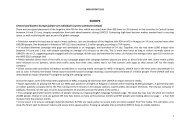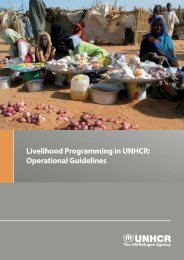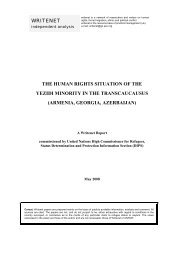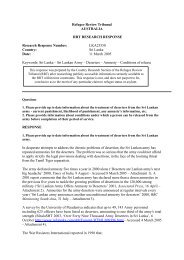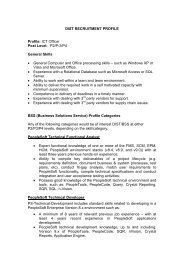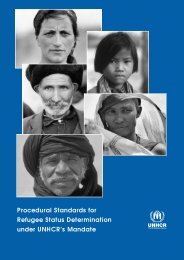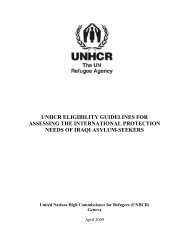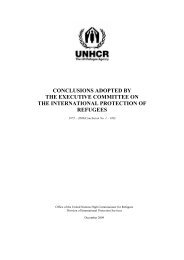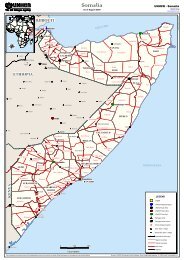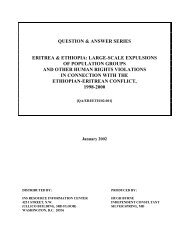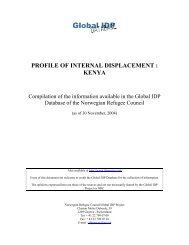UNHCR's ELIGIBILITY GUIDELINES FOR ASSESSING THE ...
UNHCR's ELIGIBILITY GUIDELINES FOR ASSESSING THE ...
UNHCR's ELIGIBILITY GUIDELINES FOR ASSESSING THE ...
Create successful ePaper yourself
Turn your PDF publications into a flip-book with our unique Google optimized e-Paper software.
values, traditions and dresses and consider themselves as a distinct ethnic group. 206<br />
However, during the Arabization, 207 the Shabak were registered as either Kurds or Arabs.<br />
Most Shabak consider themselves Muslims (mainly belonging to the Shi’ite branch of<br />
Islam, with a smaller Sunni minority), though they follow their own unique form of Islam,<br />
which includes elements of Christianity and other religions and has its own sacred book<br />
known as Buyruk, written in the Turkoman language. There is a close relationship between<br />
the Shabak and the Yazidis, and the Shabak perform pilgrimage to Yazidi shrines. 208 The<br />
Shabak language is called Shabaki and is related to Kurdish, Turkish, Farsi and Arabic. 209<br />
As there is no recent or non-politicized census, there are no clear estimates as to the number<br />
of Shabak in Iraq and estimates range from 15,000 to 400,000 persons. 210 They<br />
predominantly reside in Mosul city (mainly on the left side of the Tigris river) and in towns<br />
and villages of the Ninewa Plain such as Nimrod, Qaraqosh, Bartilla, Basheqa and Telkep.<br />
According to Dr. Hunain Al-Qaddo, 211 the Shabak comprise a third of the inhabitants of the<br />
town of Bartilla. 212<br />
During the Arabization campaign, numbers of Shabak were forcibly expelled from their<br />
places of origin in the Governorate of Ninewa. According to Dr. Hunain Al-Qaddo, the<br />
former regime destroyed 22 Shabak villages and deported 3,000 families to the north of<br />
Iraq. Reportedly, many Shabak were falsely accused by the former regime of being<br />
members of the Shi’ite Dawa Party and were executed. 213<br />
Like other religious minorities, the Shabak have come under increasing pressure from<br />
Islamic extremists. The fact that the Shabak primarily adhere to the Shi’ite branch of Islam<br />
makes them a target for Sunni Islamists. Others may look at them as “infidels” altogether<br />
given that they adhere to a distinct form of Islam. Possibly, they may also be targetted<br />
based on their (perceived) Kurdish ethnicity. 214 UNAMI HRO reported that Shabak in the<br />
aim of being recognized as a distinct ethnic group; however this demand was not met with sympathy by the<br />
Kurds.<br />
206<br />
In 1952, the Shabak were recognized as distinct ethnic group in Iraq. Therefore, consideration could also<br />
be given to persecution on the basis of ethnicity.<br />
207<br />
On the former Governments’ Arabization policies, see “De-Arabization”.<br />
208<br />
Encyclopaedia of the Orient, Shabak, see above footnote 203. See also: AINA, Kurdish Gunmen Open<br />
Fire on Demonstrators in North Iraq, 16 August 2005, http://www.aina.org/news/20050816114539.htm.<br />
209<br />
Dr. Hunain Al-Qaddo, Iraq’s Shabaks Are Being Oppressed By Kurds, 28 August 2005,<br />
http://www.aina.org/guesteds/20050828120403.htm.<br />
210<br />
During the former regime’s Arabization campaign, the Shabak were defined as either Arabs or Kurds and<br />
as a result census figures do not exist for Shabak. See, for example, American Aid for Children of Nineveh,<br />
Ethnic Groups in Nineveh, Shabak Culture, http://www.iraqkids.org/ethnicdetail.html [accessed January<br />
2007]. See also: Al-Qaddo, see above footnote 209, and ibidem, A letter from the Rep. of Shabak in the<br />
National Assermbly, 23 August 2005, http://www.christiansofiraq.com/shabak8235.html.<br />
211<br />
Dr. Hunain Al-Qaddo is the General Secretary of the Democratic Shabak Assembly and former Shabak<br />
representative in the TNA. He was also a member of Iraq’s Constitution Drafting Committee and Chairman of<br />
the Iraqi Minorities Council.<br />
212<br />
Al-Qaddo, see above footnote 209.<br />
213<br />
Ibid.<br />
214<br />
See also “Kurds, Arabs, Turkmen428F, Ethnic-Based Christian Groups (Assyrians, Chaldeans,<br />
Armenians)429F, Yazidis430F and Shabak431F in Ethnically Mixed Areas”, “Actual or Perceived<br />
56




